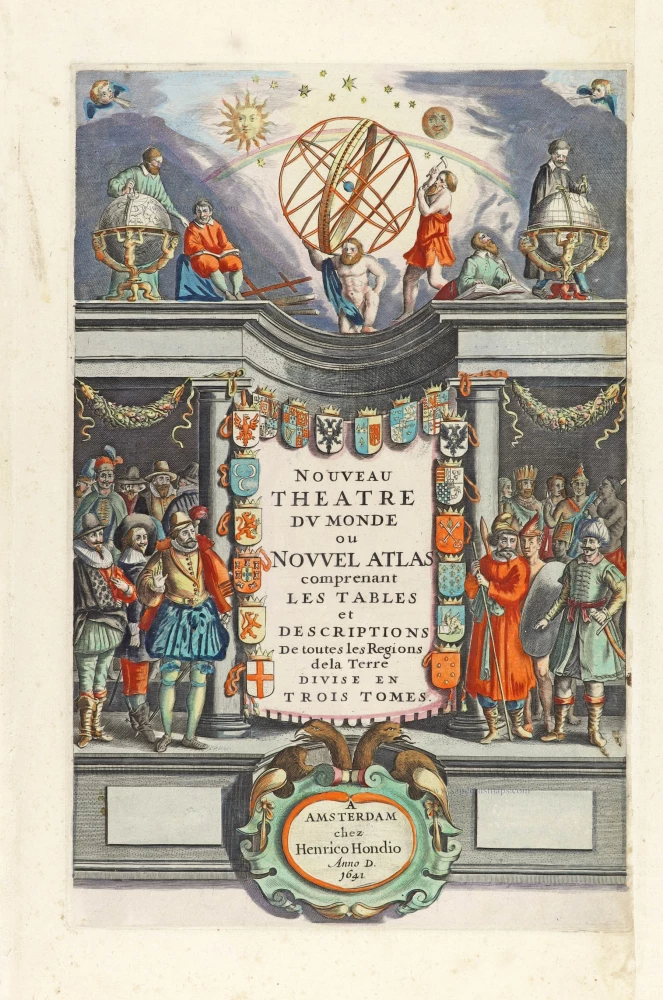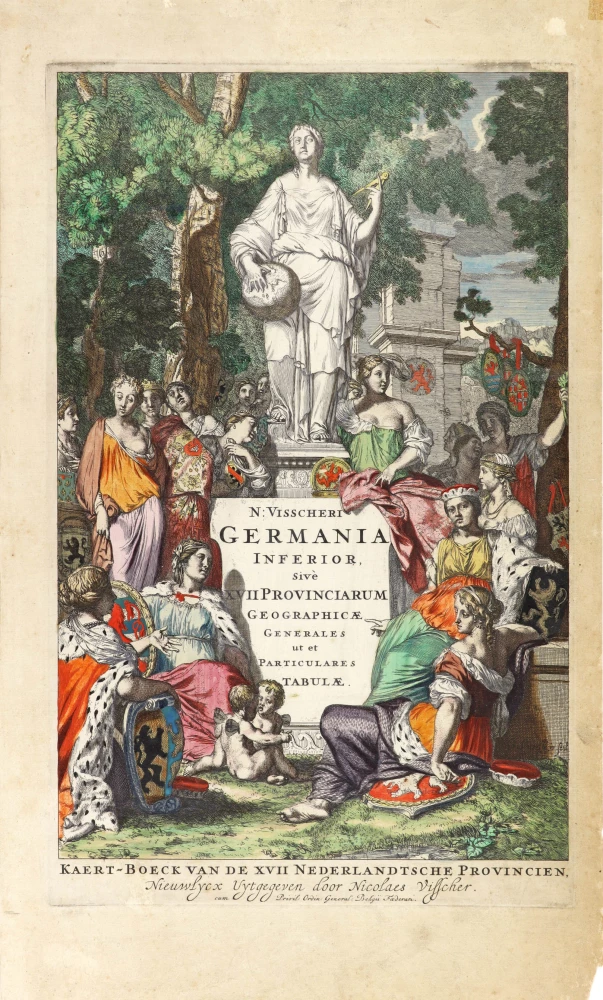Allegorical atlas title page by Henricus Hondius. 1641
The early editions of Hondius's Atlas Appendix incorporated a different title page to the Mercator-Hondius title page that had been used for many years. The main central part containing the title is now the front of a pillared proscenium or stage. Around the title panel are hung armorial shields of the main countries depicted in the atlas, and on either side are groups of figures. Those on the left represent well-dressed courtiers or merchants from the civilised West. To the right are somewhat rougher figures from the east. Their leading figure grasps his sword, whereas his opposite figure in the western group raises his hand as if in polite admonition. Both groups eye each other warily.
At the top of the title page is a mixture of mythical and contemporary figures. Atlas casually holds up an armillary sphere with one hand while Vulcan hammers in a few last rivets; there are images of the sun, the moon, the stars and the zodiac. On either side are sages demonstrating to an adjacent scribe the mysteries of a celestial sphere (to the left) of a terrestrial globe (to the right), each globe resting on grotesque pedestals. At the foot of the Hapsburg double-headed eagle heads a cartouche with the sole imprint of Henricus Hondius in Amsterdam and the date 1641. Later, in 1642, the double-headed eagle was replaced by a crown reflecting the new status of the free Dutch provinces. (Shirley)
The Hondius Family
Jodocus Hondius the Elder (1563-1612)
Joost d’Hondt was born at Wakken (Flanders) in 1563. Two years later, his family settled down in Ghent, where young Joost displayed a great gift for drawing and calligraphy. By study and lessons, he developed his talents and became an engraver with a good reputation.
Due to the circumstances of war, he moved in 1584 to London where he settled down as an engraver, instrument-maker and map-maker. In 1587, he married Coletta van den Keere, sister of the well-known engraver, Pieter van den Keere (Petrus Kaerius); some years earlier his sister, Jacomina, had married Pieter van den Berghe (Petrus Montanus). Joost, who had latinized his name to Jodocus Hondius, closely co-operated with his two brothers-in-law.
The political situation in the Northern Netherlands in 1593 was such that Jodocus seemed to be justified in establishing himself in Amsterdam, where so many Antwerp printers, publishers, and engravers had gone. In this new centre of cartography, Jodocus Hondius set up his business “In de Wackere Hondt” (in the vigilant dog), this name being an allusion to his birthplace and name. Here he engraved many maps and published atlases and many other works such as his continuation of Gerard Mercator’s Atlas.
He suddenly passed away in February 1612. The publishing firm of Jodocus Hondius was continued by his widow; later on by his two sons Jodocus Jr., and Henricus, and by his son-in-law, J. Janssonius.
Jodocus Hondius II (1594-1629) & Henricus Hondius (1597-1651)
After the father’s death, the widow with her seven children continued publishing the atlases under the name of Jodocus Hondius till 1620. The firm was reinforced by the very welcome help of Joannes Janssonius (1588-1664), who married 24-year-old Elisabeth Hondius in 1612. After 1619 Mercator’s Atlas was published under the name of Henricus Hondius.
One of the most dramatic events in the early history of commercial cartography in Amsterdam was the sale of Jodocus Hondius Jr.’s copper-plates to Willem Jansz. Blaeu in 1629, the year of his death. At least 34 plates, from which Jodocus II had printed single-sheet maps for his own benefit, passed into the hands of his great competitor. Immediately after that, his brother, Henricus, and Joannes Janssonius ordered the engraving of identical plates.
During a long period, Henricus devoted all his energy to the publication of the Atlas. He saw its growth up to, and including, the fourth part in 1646; after that, his name does not figure any more on the title-pages. After 1638, the title of the Atlas was changed to Atlas Novus; it was mainly carried on by Joannes Janssonius.
The competition with the Blaeus dates from 1630. In 1630, Willem Janszoon (=Blaeu) made the first attack with his Atlantis Appendix. In 1635, Blaeu completed his Theatrum orbis terrarum in two volumes with texts in French, Latin, Dutch, and German, which prompted Henricus Hondius to speed up the enlargement of his Atlas.
Nouveau Theatre du Monde ou Nouvel Atlas comprenant Les Tables et Descriptions de toutes les Regions de la Terre.
Item Number: 30116 Authenticity Guarantee
Category: Antique maps > Curiosities
Old, antique of Allegorical atlas title page by Henricus Hondius.
Title: Nouveau Theatre du Monde ou Nouvel Atlas comprenant Les Tables et Descriptions de toutes les Regions de la Terre.
Divisé en trois tomes.
A Amsterdam chez Henrico Hondio Anno D. 1641.
Copper engraving, printed on paper.
Image size: 370 x 240mm (14.57 x 9.45 inches).
Sheet size: 485 x 285mm (19.09 x 11.22 inches).
Verso: Blank.
Condition: Original coloured, right margin extended.
Condition Rating: A.
From: Nouveau Theatre du Monde ou Nouvel Atlas comprenant Les Tables et Descriptions de toutes les Regions de la Terre. Amsterdam, Henricus Hondius, 1641. (Van der Krogt 1, 412)
The early editions of Hondius's Atlas Appendix incorporated a different title page to the Mercator-Hondius title page that had been used for many years. The main central part containing the title is now the front of a pillared proscenium or stage. Around the title panel are hung armorial shields of the main countries depicted in the atlas, and on either side are groups of figures. Those on the left represent well-dressed courtiers or merchants from the civilised West. To the right are somewhat rougher figures from the east. Their leading figure grasps his sword, whereas his opposite figure in the western group raises his hand as if in polite admonition. Both groups eye each other warily.
At the top of the title page is a mixture of mythical and contemporary figures. Atlas casually holds up an armillary sphere with one hand while Vulcan hammers in a few last rivets; there are images of the sun, the moon, the stars and the zodiac. On either side are sages demonstrating to an adjacent scribe the mysteries of a celestial sphere (to the left) of a terrestrial globe (to the right), each globe resting on grotesque pedestals. At the foot of the Hapsburg double-headed eagle heads a cartouche with the sole imprint of Henricus Hondius in Amsterdam and the date 1641. Later, in 1642, the double-headed eagle was replaced by a crown reflecting the new status of the free Dutch provinces. (Shirley)
The Hondius Family
Jodocus Hondius the Elder (1563-1612)
Joost d’Hondt was born at Wakken (Flanders) in 1563. Two years later, his family settled down in Ghent, where young Joost displayed a great gift for drawing and calligraphy. By study and lessons, he developed his talents and became an engraver with a good reputation.
Due to the circumstances of war, he moved in 1584 to London where he settled down as an engraver, instrument-maker and map-maker. In 1587, he married Coletta van den Keere, sister of the well-known engraver, Pieter van den Keere (Petrus Kaerius); some years earlier his sister, Jacomina, had married Pieter van den Berghe (Petrus Montanus). Joost, who had latinized his name to Jodocus Hondius, closely co-operated with his two brothers-in-law.
The political situation in the Northern Netherlands in 1593 was such that Jodocus seemed to be justified in establishing himself in Amsterdam, where so many Antwerp printers, publishers, and engravers had gone. In this new centre of cartography, Jodocus Hondius set up his business “In de Wackere Hondt” (in the vigilant dog), this name being an allusion to his birthplace and name. Here he engraved many maps and published atlases and many other works such as his continuation of Gerard Mercator’s Atlas.
He suddenly passed away in February 1612. The publishing firm of Jodocus Hondius was continued by his widow; later on by his two sons Jodocus Jr., and Henricus, and by his son-in-law, J. Janssonius.
Jodocus Hondius II (1594-1629) & Henricus Hondius (1597-1651)
After the father’s death, the widow with her seven children continued publishing the atlases under the name of Jodocus Hondius till 1620. The firm was reinforced by the very welcome help of Joannes Janssonius (1588-1664), who married 24-year-old Elisabeth Hondius in 1612. After 1619 Mercator’s Atlas was published under the name of Henricus Hondius.
One of the most dramatic events in the early history of commercial cartography in Amsterdam was the sale of Jodocus Hondius Jr.’s copper-plates to Willem Jansz. Blaeu in 1629, the year of his death. At least 34 plates, from which Jodocus II had printed single-sheet maps for his own benefit, passed into the hands of his great competitor. Immediately after that, his brother, Henricus, and Joannes Janssonius ordered the engraving of identical plates.
During a long period, Henricus devoted all his energy to the publication of the Atlas. He saw its growth up to, and including, the fourth part in 1646; after that, his name does not figure any more on the title-pages. After 1638, the title of the Atlas was changed to Atlas Novus; it was mainly carried on by Joannes Janssonius.
The competition with the Blaeus dates from 1630. In 1630, Willem Janszoon (=Blaeu) made the first attack with his Atlantis Appendix. In 1635, Blaeu completed his Theatrum orbis terrarum in two volumes with texts in French, Latin, Dutch, and German, which prompted Henricus Hondius to speed up the enlargement of his Atlas.



